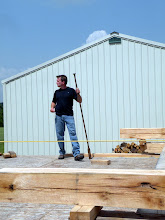
The first time I used a draw knife was to build my first chair. Man were my hands sore and my thumbs were numb from gripping this tool learning and feeling it's power. I only thought I had control of this simple tool but was fighting what I did not understand. What I quickly learned was how the relationship between the blade and handles determined whether the tool should be used bevel up or down. From what I have learned over the years is that when the handles are in line with the blade then it is a bevel down knife. Using the bevel down knife gives you more freedom to cut coves such as the side of windsor seats. When the handles are not in line with the blade you use the knife bevel up. The flat back of the blade will ride along the long fibers of the wood giving you great control to follow the grain. The best way to check which knife you have is to sit down at the shave horse and pull the knife toward you till it starts to cut. At that point if your wrist are popped up higher than your hands then flip the knife over and try again. Your wrist should be in line or slightly lower than your hands and the knife should perform much better.
When making spindles for windsor chairs I like the control I get with a "bevel up" knife. Most of the knives I have are "bevel down" . Upon reading Pete Galbert's post on replacing the handles on his draw knives I saw my opportunity to finally fix all my knives to perfection. At least to me. I had 3 knives to repair handles and two of them to turn into a bevel up draw knife by simply bending the handles. Now I did the first one cold with no problems. If you have really thick metal you could use a small torch to heat the handles (after the wood handles are removed) to aid in bending. Just stay away from the blade so you don't lose the temper of the steel. The picture below shows the handle furthest away from you still in line with the blade and the handle closest has already been bent. It is not a severe bend at all and could be done with the wood handles on in a metal vise and padded vise grips. If you were to make a pommel knife by bending the handle straght out on one side then heating to a cherry red is a must or the arm would most likely break. 


Here are some shots of one of the draw knives after turning new handles and bending to make a bevel up knife. After sharpening this $12 flea market knife really sings. I'll let the pictures speak for themselves. See Pete's blog on how he did this.



 Stay tuned for the restoration of uncle Kenny's adze. He gave this to me to use on the soon to be floor joist for the new loft. It had a tobacco stick for a handle and he used it to dig the weeds from the garden.
Stay tuned for the restoration of uncle Kenny's adze. He gave this to me to use on the soon to be floor joist for the new loft. It had a tobacco stick for a handle and he used it to dig the weeds from the garden.







